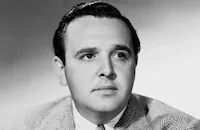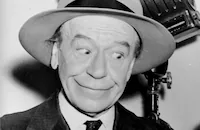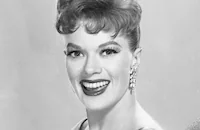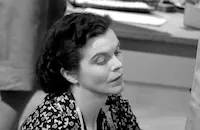Bathing Beauty

Brief Synopsis
Cast & Crew
George Sidney
Red Skelton
Esther Williams
Basil Rathbone
Bill Goodwin
Jean Porter
Film Details
Technical Specs

Synopsis
In Los Angeles, popular songwriter Steve Elliott prepares to marry Caroline Brooks, who has pledged to give up her job as a college swimming instructor once she has wed. Likewise, Steve plans to quit his songwriting career, even though New York producer George Adams has already hired him to write new songs for a water ballet show. When George overhears Steve discussing his "retirement" with Caroline, he vows to prevent the marriage and enlists Maria Dorango, an aspiring actress posing as a Latin American singer, to help him. Moments after a justice of the peace pronounces the redheaded Steve and Caroline man and wife, Maria rushes in, claiming that Steve is her husband and the father of her three redheaded children. Although Steve pleads his innocence, Caroline storms off in a rage and returns to her teaching post at Victoria College in New Jersey. A determined Steve and his friend, Carlos Ramirez, follow her there, but are denied entrance to the all-female school. Later, in a New York nightclub, Steve meets drunken lawyer Chester Klazenfrantz and learns that Klazenfrantz has been hired to change the charter of Victoria College, which has never officially designated itself as all-female. Armed with this information, Steve returns to Victoria and insists on applying for admission. Unaware of Caroline's relationship to Steve, Dean Clinton suggests to the faculty that he be admitted for a two-week probationary period, during which time they would give him 100 demerits, which would qualify him for expulsion before Parents Day. Once enrolled, Steve tries to speak with Caroline, but she refuses to listen to his explanations and tells him she is seeking an annulment. Later, in music class, stodgy Professor Hendricks attempts to discredit Steve, whose presence on campus has created a furor among the co-eds, by ordering him to write his own version of the Scottish ballad "Loch Lomond" and teach the next day's class. With help from several talented students, Carlos and their friend Harry James and his orchestra, Steve meets Hendricks' challenge and is awarded an "A." That night, Steve visits Caroline at her house, but is turned out after Willis Evans, a conservative botany professor who is in love with Caroline, arrives. When Caroline realizes that Steve is hiding in her closet, spying on her, she commands Willis' Great Dane to guard the closet door, while reminding Steve that unless he is in his room in five minutes, he will be expelled for breaking curfew. With only seconds to spare, Steve manages to trick the dog long enough to escape back to his dingy basement room. Steve is then visited by George, who threatens to vilify him in the press unless he finishes his songs. When Steve swears deadly revenge on the person who hired Maria, however, George backs down and offers to help Steve do his homework. Concerned about the approaching Parents Day, Dean Clinton, meanwhile, commands Steve's professors, who have penalized him with only fifty-five demerits, to bear down on him. To that end, Mme. Zarka, Steve's ruthlessly strict ballet teacher, forces him to wear a tutu and dance with the co-eds, but Steve once again rises to the occasion. A now desperate Dean Clinton asks Caroline to go out with Steve and ensure that he arrives back at Victoria after the curfew. Caroline agrees, but during the evening, Steve convinces her of his innocence, and as they drive back to school, the newlyweds make plans to return to California together. Unknown to Caroline and Steve, Maria is on campus, looking to expose George, who has been trying to get rid of her, to Steve. At the same time, a campus sororiety descends on Steve's room, hoping to initiate him, and Jean Allenwood, another co-ed, shows up with news that her parents and Dean Clinton are on their way over to inspect his room. As Steve desperately hides all the women in two closets and keeps Caroline from discovering Maria, George unexpectedly arrives. Although Steve succeeds in hiding George and himself and fooling Dean Clinton and the Allenwoods, Maria soon makes her presence known to Caroline, who once again leaves in a fury. Later, Steve promises to write songs for George's water ballet show on condition he make Caroline the star. George agrees, and after Maria is finally able to tell Caroline the truth, Caroline happily reunites with Steve, who then gives George a thrashing.

Director

George Sidney
Cast

Red Skelton

Esther Williams

Basil Rathbone

Bill Goodwin

Jean Porter

Nana Bryant
Carlos Ramirez

Donald Meek
Jacqueline Dalya
Francis Pierlot
Ann Codee

Margaret Dumont
Bunny Waters

Janis Paige
Ethel Smith

Xavier Cugat

Lina Romay
Harry James
Helen Forrest
Buddy Foreno
Eloise Rawitzer
Harry Stanton
Frank Holiday Jr.
George Pitman
Bob Priester
Harry Von Schloeten
Allan Watson
Guadalajara Trio
Mary C. Taylor
Sarah Edwards
Almira Sessions
Elspeth Dudgeon
Earl Schenck

Dorothy Adams
Shelby Payne
Alphonse Martell
John Lopez
Andrew Tombes
Jane Green
Douglas Berle
Donald Davis
Danny Reilley
Harry Hayden
Jane Isbell

Joe Yule
Mary Ann Hawkins
Douglas Morrow

Eddie Kane

Ray Teal

Russell Hicks
Celia Travers
Herbert Evans
Bertha Priestley
Helen O'hara
Mary Ganley
Dorothy Ford
Noreen Roth
Vicky Lane
Margaret Adams
Linda Deane
Erin O'kelly
Margaret Adden
Constance Weiler
Naomi Scher
Katharine Booth

Beverly Tyler
Alice Eyland
Muriel Morris
Ann Lundeen
Charmienne Harker
Lucille Casey
Bonnie Edwards
Dolores Dey
Beryl Mccutcheon
Peggy Maley
Mary Perine
Gloria Lake

Betty Jaynes
Aina Constant
Mildred Riley
Sarah Wallace
Pat Dean
Betty Lou Hanson
Crew
Zequínha De Abreu
Harold Adamson
Robert Alton
John Murray Anderson
Gus Arnheim
Allen Boretz
John A. Camacho
Xavier Cugat
Jack Cummings
Fausto Curbelo
Jack Dawn
Merwin Daynes
Kay Dean
Grigoras Dinicu
Jack Donohue
Ted Duncan
Kenneth Earl
Arthur Freed
Cedric Gibbons
Stephen Goossón
Johnny Green
Johnny Green
Maria Grever
Pedro Elias Gutierez
Jascha Heifetz
Irene
Calvin Jackson
Henry Jaffa
Harry James
Natalie Kalmus
Curtis Kenyon
Dorothy Kingsley
Ben Libizer
T. Lieurance
Abe Lyman
Jack Matthias
Noro Morales
Edith Motridge
M. M. Musselman
Mclean Nisbet
Merrill Pye
Sandy Ross
George Ryan
Joseph Schrank
Blanche Sewell
Sharaff
Douglas Shearer
Harry Stradling
Peter Ilyich Tchaikovsky
Johnny Thompson
Frank Waldman
Frances Wayne
Herman Webber
Ted Weisbarth
Edwin B. Willis

Photo Collections
Videos
Movie Clip



Trailer
Hosted Intro
Film Details
Technical Specs

Articles
Bathing Beauty
Originally a vehicle for Skelton called Mr. Co-ed, Bathing Beauty was tailored to promote Williams and her unique water talents. She plays a swimming teacher at an all-girls' school, where Skelton's enamored songwriter enrolls to be near his lady love.
But the plot takes a back seat to the dazzling underwater dance numbers and the memorable water spectacle conclusion. Surrounded by a flood of water maidens, Williams glides through a pool with fountains gushing high and torches of fire burning to a glorious Technicolor end. The sequence was produced by John Murray Anderson, the choreographer for the famous Billy Rose Aquacade in San Francisco where Williams had once worked.
Giving added zest to the movie, Harry James and his orchestra along with America's "Rumba King" Xavier Cugat swing with tunes such as "Bim, Bam, Boom" and "Hora Staccato."
Bathing Beauty was Williams' third film, but first all-out swimming vehicle and was among her favorites. "Bathing Beauty has to be top on my list," Williams has said. But, she conceded, "They were all fun." The film launched her Hollywood career, or as Variety said in its review of the movie in 1944, she was "pulled to stardom by her swim-suit straps."
Out of the water, Bathing Beauty showcases one of Skelton's funniest screen moments in which he attends a girls' ballet class dressed in a fluffy pink tutu. The scene was so popular, it was re-used as a flashback sequence in The Clown (1953), one of his films made almost ten years later.
Skelton got his start in vaudeville and burlesque while in his teens before entering the movie business in the 1940s. Called one of the most likeable comedians of all time, Skelton later achieved even greater stardom when his self-titled TV show debuted in 1951 and ran for two decades.
While Skelton dove into show business whole-heartedly, getting Williams to the big screen was not an easy task. The former swimming champ and Olympic hopeful turned down initial offers when Hollywood came calling, instead focusing on her work at the Billy Rose Aquacade and later, turning her attention to married life. But after about a year, MGM's persistence paid off, and she signed with them in 1941, providing the studio a star for their "aqua musicals."
Despite their different approaches to the entertainment industry, the chemistry between Skelton and Williams worked well, and they later teamed up for Neptune's Daughter in 1949 and 1951's Texas Carnival.
Williams spent the next decade after Bathing Beauty becoming one of the biggest box office draws with the help of movies such as Take Me Out to the Ball Game (1949), Million Dollar Mermaid (1952), and Jupiter's Darling (1955).
Producer: Jack Cummings
Director: George Sidney
Screenplay: Kenneth Earl, M.M. Musselman, Curtis Kenyon, Joseph Schrank, Dorothy Kingsley, Allen Boretz, Frank Waldman
Cinematography: Harry Stradling
Film Editing: Blanche Sewell
Art Direction: Cedric Gibbons, Stephen Goosson, Merrill Pye
Music: Johnny Green
Cast: Red Skelton (Steve Elliot), Esther Williams (Caroline Brooks), Basil Rathbone (George Adams), Bill Goodwin (Professor Willi Evans), Jean Porter (Jean Allenwood), Nana Bryant (Dean Clinton).
C-102m. Closed captioning.
by Amy Cox

Bathing Beauty
Quotes
Trivia
Notes
The working title of this film was Mr. Co-ed. According to an unidentified source in the file for the film at the AMPAS Library, the original story was titled "Sink or Swim." Excerpts from Xavier Cugat's "Thrill of a New Romance" and Carlos Ramirez and Harry James's "Boogie Woogie" are heard during the water ballet sequence. In the film, Red Skelton does an extended, comic impression of a woman waking up and dressing. Ethel Smith, a popular organist who performed on the radio show The Hit Parade, made her screen debut in the film. Smith was later featured in several additional M-G-M films.
In late 1940, M-G-M announced plans to shoot a film entitled Mr. Co-ed, starring Marjorie Main, Myrna Loy and William Powell and directed by Jack Conway. According to Hollywood Reporter news items, Palo Alto and Berkeley, CA, were scouted as possible locations for that production in December 1940, but because of script problems, the project was shelved in early January 1941. It has not been determined whether the 1940 Mr. Co-ed project was in any way related to the 1944 Bathing Beauty.
Hollywood Reporter news items provide the following information about the production of Bathing Beauty: In February 1942, Irving Starr was assigned as the film's producer. In September 1942, Harry Clork was hired to write the screenplay, but his contribution to the completed film has not been confirmed. Songwriters Don Raye and Gene de Paul were originally signed to write the film's numbers, which were to feature Phil Spitalny's all-girl orchestra, and Lennie Hayton was to score the picture. Jimmy McHugh and Al Dubin were then hired to write songs with a "Latin-American flavor" for Ramirez and Cugat. Although Janis Paige was to sing "How Can I Hold You Close Enough" by Johnny Green, that number was not included in the final film. Swimming sequences were filmed at the Lakeside Country Club in Toluca Lake, CA. According to a Life magazine spread about the production, a special crane was used for the water ballet sequence to allow the camera to move horizontally and vertically at the same time. For underwater shots in the 90-foot pool, the camera was encased in a specially constructed "aquachamber," which resembled a phone booth. M-G-M makeup artist Jack Dawn adapted an "ancient Chinese invention" to create the first "waterproof coiffure" for the production, which reportedly enabled the swimmers to dive into swimming pools without damaging their elaborate headdresses. (Modern sources claim, however, that Vaseline petroleum jelly was applied). According to a M-G-M publicity item, makeup artist Benny Libizer designed for the film a makeup applicator called an "aquapuff," which was used to apply waterproof, liquid makeup to the swimmers between shots.
According to Hollywood Reporter, M-G-M dance instructor Joe Hickey was to perform a featured dance number in the picture, but his appearance in the final film has not been confirmed. Hollywood Reporter news items list the following actors as cast members: Florence Lundeen, Peggy O'Neill, Frances McInerney, Pat Hogan, Florence Turner, Marion Ackerson, Barbara Brewer, Valeria Brownell, Bonnie Jean Hartley, Carol Sawyer, Ethel Sherman, Gloria Sherwood, Diana Cannon, Ruth Harrah, Margaret Greene, Marilyn Perkins, Frances Eilerson, Molly Ann French, Barbara Heglar, Catherine Livingston, Edith Pemberton, Adele Peterson, Shirley Schubert, Kay Shaw, Earlynne Waterston, Barbara Gagnon, Marek Windheim, Kay Adell, Blanche Ames, Colleen Bisson, Jean James, Betty Mills, Doris Munyon, Elinor Skube, Gwen Spaulding, Margaret Thompson and Florence Warner. Their appearance in the completed film has not been confirmed, however.
An October 1943 M-G-M publicity item announced that the following "schoolgirls" from San Diego and La Jolla, CA swim teams were "discovered" in Los Angeles and were cast in the picture: Kay Rice, Margaret Pugh, Pat Dunlap, Mela McGonigal, Marjorie Bolinger, The Browne Twins and The Farnham Twins. According to a Hollywood Reporter news item, the Nerwin Uniswimmers were featured in the water ballet sequence. In addition, publicity items note that Martha Winter, who had held the all-time record for underwater swimming, was to make her screen debut in the water ballet sequence. The participation of these swimmers in the final film has not been confirmed, however.
Although not her debut film, Bathing Beauty marked Esther Williams' first Technicolor musical. According to Hollywood Reporter, Bathing Beauty was the first of three M-G-M films to be dubbed into Spanish for Latin American release. (Gaslight and The White Cliffs of Dover were the other two.) Xavier Cugat and Carlos Ramirez appeared in a Spanish language trailer for that release. "Tico-tico, No fubá" a Latin number played in the picture by Ethel Smith, became a hit record after the film's release.
















